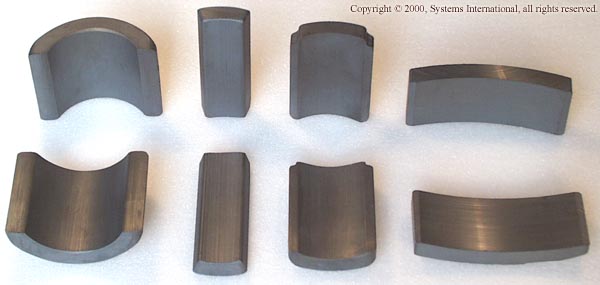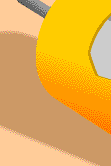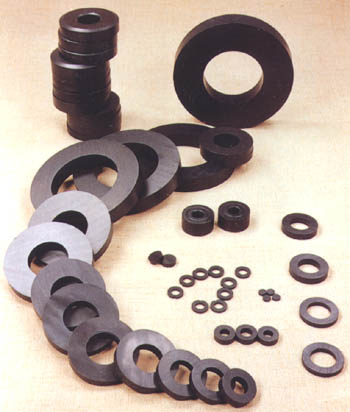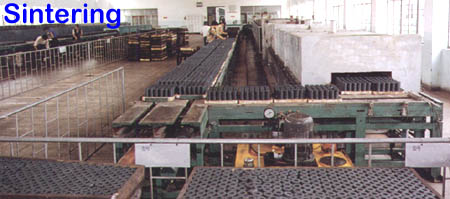![]()

|
|
||
|
|
|
|
|
|
||
|
Ferrite permanent magnets became commercially available in the mid 1950's. Ferrite permanent magnets are also commonly known as ceramic magnets, because of the process used to produce them. The raw materials used in the ferrite magnet production are iron oxide, and barium/strontium carbonate. All of these are non-strategic, plentiful available and low in cost. Ferrite, or iron oxide, is mixed with strontium and then milled to a very fine powder. The powder is then mixed with a ceramic binder and pressed into shape. These pressed parts are fired in a tunnel kiln to complete the ceramic process, sintering. The result is a hard and brittle part requiring diamond wheels for grinding to close tolerance. Ceramic magnets will not withstand the mechanical stresses required of structural members. Due to the nature of this material, small cracks, chips, porosity, etc. are common and should be expected but will not interfere with the performance of the magnets. Energy products for ferrite materials range from 1 to 4.5 MGOe and is best suited for environments under 300° C (570° F). |
||||||||||||||||||||||||||||||||||||||||||||||||||||||||||||||||||||||||||||||||||||||||||||||||||||||||||||||||||||||||||||||||||||||||||||||||
|
All of our ceramic magnets are manufactured to rigid
magnetic and physical properties that meet or exceed the Standards set by
MMPA (U.S.A.), the Magnetic Materials Producers Association of the United
States. Our Asia manufacturer is ISO-9002 and QS-9000 certified. Every manufacturing
processing includes thorough quality control. The raw materials used in the ceramic magnet production
are iron oxide, and barium/strontium carbonate. All of these are
non-strategic, plentiful available and low in cost. Ceramic magnets are
formed by compaction and sintering. The result is a hard and brittle part
requiring diamond wheels for grinding to close tolerance. Ceramic magnets
will not withstand the mechanical stresses required of structural members. Magnet Ceramic-1 is non-oriented and isotropic with equal
magnetic properties in any direction of magnetization. High-grade ceramic
magnets are oriented. They must be magnetized in the direction of
orientation, which is the same as the direction of pressing. All magnets are
available in variety of shapes and sizes, including round disks, rings,
blocks, arc segments, U-shapes, rotors, cylinders, etc. The finished products
could be magnetized or unmagnetized as user specified. If
you do not find the specific properties which you need in our catalog, please
contact us or send your inquiry and drawing to us. We would design a composition to match your specifications and
make samples for your testing. Magnetic Properties:
|
|
|
|
|
Systems International Group, Inc |







